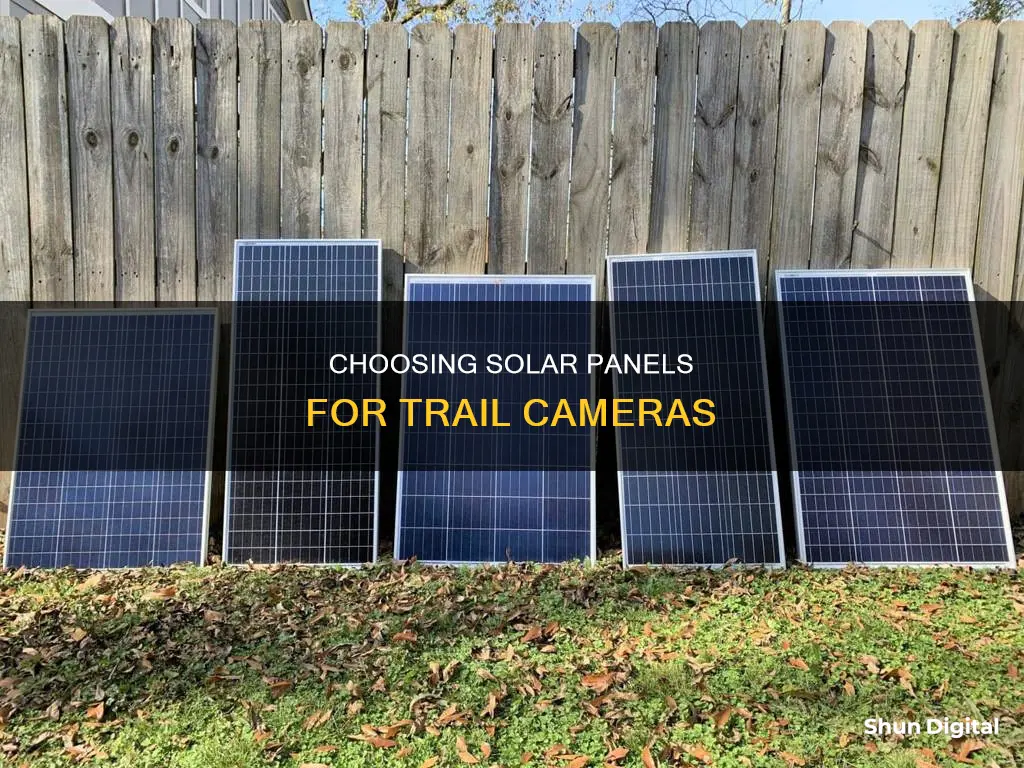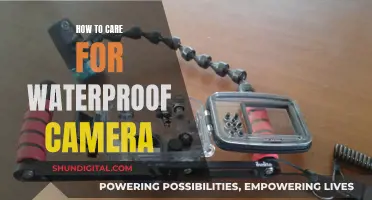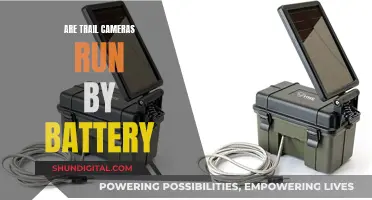
Solar panels are a great way to power game trail cameras, especially in remote locations. The right solar panel for your game trail camera battery will depend on various factors, such as the battery capacity, the location of the camera, and the amount of sunlight available.
Generally, a solar panel with a wattage of 5-10 watts and a voltage of 6-12 volts is sufficient for most game trail camera batteries. However, it's important to consider the specific needs of your camera and the environment in which it will be used. For example, if your camera is located in an area with limited sunlight, you may require a higher wattage solar panel or a larger panel to compensate for the lack of sunlight.
Recent advancements in solar technology have led to the development of more efficient and affordable solar panels that are lightweight, durable, and weather-resistant, making them ideal for use with game trail cameras. When choosing a solar panel, it's also essential to consider the efficiency of the panel, the quality of the battery, and the charging controller to ensure optimal performance.
Some popular options for trail camera solar panels include the GardePro SP350 Universal Solar Panel, Spypoint LITHIUM BATTERY SOLAR PANEL (10W), and the Browning Solar Panel Power Pack, which are compatible with various trail camera brands.
By selecting the appropriate solar panel and taking into account the specific requirements of your camera and its surroundings, you can ensure reliable and sustainable power for your game trail camera.
What You'll Learn

Solar panel wattage requirements
The wattage requirements of a solar panel for a game trail camera battery depend on several factors. These include the size of the camera's battery, the location of the camera, and the amount of sunlight available in the area.
In general, a solar panel with a wattage of 5 to 10 watts and a voltage of 6 to 12 volts is sufficient for most game trail camera batteries. A 5-watt solar panel is typically enough for game trail cameras with a 12V, 7Ah battery capacity. However, if the camera is placed in an area with limited sunlight, a higher wattage solar panel may be needed.
It is worth noting that the wattage of the solar panel is not the sole factor to consider when selecting one for a game trail camera. The efficiency of the solar panel, the quality of the battery, and the charging controller all play a significant role in determining the overall performance of the solar-powered camera system.
Recent advancements in solar technology have led to the development of more efficient and affordable solar panels. Some modern solar panels for game trail cameras are designed to be lightweight, durable, and weather-resistant, making them ideal for use in remote locations.
When choosing a solar panel for a game trail camera, it is crucial to consider the specific requirements of the camera and the environment in which it will be used. By selecting the appropriate solar panel and accessories, hunters and wildlife enthusiasts can benefit from reliable and sustainable power for their game trail cameras.
In addition to wattage, other factors such as battery capacity, location, and sunlight availability also play a role in determining the size of the solar panel needed. A larger battery will generally require a larger solar panel to ensure it is fully charged. Moreover, the solar panel should be sized proportionally to the battery capacity.
To optimise charging performance, it is important to consider the weather conditions and the angle of the sun. The solar panel should be positioned to receive maximum sunlight throughout the day, preferably facing south or southwest, and angled at around 45 degrees. Regular maintenance and cleaning of the solar panel are also necessary to ensure maximum efficiency by preventing any buildup of dirt or dust that could reduce its power generation capacity.
Charging the Panasonic Leica Dicomar Camera: A Step-by-Step Guide
You may want to see also

Factors affecting solar panel size
Several factors influence the size of the solar panel required for a game trail camera battery. These factors must be carefully considered to ensure the camera operates efficiently and sustainably.
Firstly, the size of the battery itself is a critical factor. A larger battery will require a larger solar panel to charge it effectively. This is because the solar panel must be proportional to the battery capacity to ensure it can be fully charged.
Secondly, the amount of sunlight available in the area is a significant consideration. If the camera is positioned in a location with limited sunlight, a larger solar panel may be needed to compensate for the reduced sunlight exposure. The angle of the sun and weather conditions can also impact the performance of the solar panel, so these should be taken into account when determining the size.
In addition, the power consumption of the camera is important. Cameras with higher power requirements will need a larger solar panel to maintain a charged battery. Therefore, it is crucial to select a solar panel capable of meeting the camera's power needs, especially during periods of low sunlight.
Recent advancements in solar technology have resulted in more efficient and powerful solar panels. This means that newer solar panels can provide more power in smaller sizes. However, despite these advancements, it is still necessary to consider the size of the battery and the available sunlight when choosing a solar panel for a game trail camera.
Outdoor Wi-Fi Camera Battery Life: How Long Does It Last?
You may want to see also

Recommended solar panel size
The recommended solar panel size for a game trail camera battery depends on various factors, including the battery capacity, the location of the camera, and the amount of sunlight available. It is also important to consider the power consumption of the camera and the efficiency of the solar panel.
In general, a solar panel with a wattage output of 5 to 10 watts is sufficient for most game trail camera batteries. A higher wattage solar panel may be required if the camera is located in an area with limited sunlight. Additionally, it is recommended to use a solar panel with a built-in charge controller to prevent overcharging the battery.
The size of the solar panel should be proportional to the battery capacity. For larger batteries, a larger solar panel will be necessary to ensure optimal charging. The placement of the solar panel is also crucial, as it should be positioned to receive maximum sunlight throughout the day.
With advancements in solar technology, smaller and more compact solar panels are now available for game trail cameras. These panels can provide reliable and sustainable power in remote locations without frequent battery replacements. Some manufacturers have even developed solar panels specifically for game trail cameras, which are compact and easy to install.
When choosing a solar panel for a game trail camera, it is important to consult the manufacturer's specifications for the camera and battery to ensure compatibility and optimal performance.
Charging Camera Batteries: How Long is Too Long?
You may want to see also

Solar panel placement
It is recommended to angle the solar panel at a 45-degree angle to maximize the capture of the sun's rays. This strategic angling ensures that the panel can absorb sunlight effectively, even during times of the day when the sun's position may be lower in the sky. Regularly adjusting the angle according to the changing position of the sun throughout the year can further optimize charging performance.
Additionally, maintaining a clean and debris-free solar panel surface is essential for maximum efficiency. Dirt or dust buildup can reduce the panel's ability to generate power. Therefore, regular maintenance and cleaning are crucial to ensuring the solar panel functions optimally.
The placement of the solar panel should also consider the length of the connecting cable to the game trail camera. Proper placement ensures that the cable is not overly stretched or strained, reducing the risk of damage to the cable and maintaining a reliable connection between the solar panel and the camera.
By following these guidelines for solar panel placement, hunters and wildlife enthusiasts can maximize the charging performance of their game trail camera batteries, ensuring reliable and sustainable power for their equipment.
Uncover the Brand Behind Wall Charger Spy Cameras
You may want to see also

Solar panel efficiency and affordability
Solar panel efficiency is a measurement of how much of the sun's energy a panel can convert into usable electricity. The efficiency of a solar panel is determined by various factors, including the type of solar panel, the amount of sunlight, and the temperature.
There are three main types of solar panels: monocrystalline, polycrystalline, and thin-film. Monocrystalline panels are the most efficient, with a rating of 17% to 22%, followed by polycrystalline panels at 15% to 17%, and thin-film panels at 10% to 13%. Monocrystalline panels are made from a single silicon ingot, making them purer and more efficient but also more expensive. Polycrystalline panels are made from multiple silicon sources, resulting in imperfections that limit their efficiency. Thin-film panels are the least expensive but also the least efficient, typically used in commercial installations.
The amount of sunlight and the angle of the panels also play a crucial role in efficiency. Solar panels work best when they receive direct sunlight, so shade, clouds, and the angle of the panels can impact their performance. Additionally, the temperature affects efficiency, with ideal panel temperatures around 25°C (77°F). Higher temperatures cause a slight decrease in efficiency, while cooler temperatures can enhance performance.
While higher-efficiency solar panels are advantageous, especially in limited space or shading situations, it's important to consider the overall output, cost, and other factors when choosing a solar panel system. The efficiency of solar panels has improved significantly over the years, and advancements in technology continue to drive progress in this area.
Charging Your Link-S LTE Camera: A Quick Guide
You may want to see also
Frequently asked questions
The size of the solar panel you need depends on factors such as the battery capacity, the location of the camera, and the amount of sunlight available.
Generally, a solar panel with a wattage of 5-10 watts and a voltage of 6-12 volts is sufficient. However, it's important to consult the manufacturer's specifications for your camera and battery to determine the appropriate size.
Some recommended solar panels include the GardePro SP350 Universal Solar Panel, the Tactacam Reveal Solar Panel, and the Spypoint LITHIUM BATTERY SOLAR PANEL (10W).
Solar panels offer a reliable and sustainable power source for game trail cameras, eliminating the need for frequent battery replacements. They are also lightweight, durable, and weather-resistant, making them ideal for remote locations.







